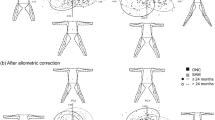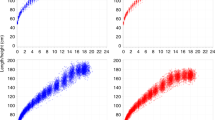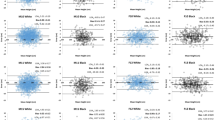Abstract
Objectives: To investigate appropriate measurements to predict height in children with physical impairments to facilitate the accurate assessment of nutritional status in field studies.
Design: Case–control cross-sectional study.
Setting: Dharavi, a large slum in Mumbai, India.
Subjects: In total, 141 children with mixed disabilities and 162 nondisabled control children, aged 2–6 y.
Methods: Height/length, armspan, arm length and tibia length were measured to the nearest 0.1 cm using standard procedures. The relations between armspan, arm length and tibia length with height in controls were investigated using linear regression.
Results: Armspan (R2=0.93, P<0.001, n=158), arm length (R2=0.81, P<0.001, n=162) and tibia length (R2=0.72, P<0.001, n=161) were found to be strong predictors of height based on data from nondisabled control children. These measurements could be used to determine a more accurate height for children with physical impairments where the nature of the impairment may interfere with height measurements.
Conclusions: Armspan, arm length and tibia length can be used to determine accurate height for children with physical impairments, for example, children with a nonambulatory status or those with kyphosis or scoliosis of the spine.
Sponsorship: Department for International Development (DFID), UK.
This is a preview of subscription content, access via your institution
Access options
Subscribe to this journal
Receive 12 print issues and online access
$259.00 per year
only $21.58 per issue
Buy this article
- Purchase on Springer Link
- Instant access to full article PDF
Prices may be subject to local taxes which are calculated during checkout
Similar content being viewed by others
References
Bassey JE (1986): Demi-span as a measure of skeletal size. Ann. Hum. Biol. 13, 499–502.
Dahl M & Gebre-Medhin M (1993): Feeding and nutritional problems in children with cerebral palsy and myelomeningocoele. Acta Paediatr. 82, 816–820.
Dahl M, Thommessen M, Rasmussen M & Selberg T (1996): Feeding and nutritional characteristics in children with moderate or severe cerebral palsy. Acta Paediatr. 85, 697–701.
De Lucia E, Lemma F, Tesfaye F, Demisse T & Ismail S (2002): The use of armspan measurement to assess the nutritional status of adults in four Ethiopian ethnic groups. Eur. J. Clin. Nutr. 56, 91–95.
Gibson RS (1990): Principles of Nutritional Assessment. New York, USA: Oxford University Press.
HelpAge International and London School of Hygiene and Tropical Medicine (LSHTM) (1997): Assessing the Nutritional Vulnerabilities of Older People in Developing Countries, eds K Gregory & K Peachy. London, UK: London School of Hygiene and Tropical Medicine.
Hogan SE (1999): Knee height as a predictor of recumbent length for individuals with mobility-impaired cerebral palsy. J. Am. Coll. Nutr. 18, 201–205.
Mitchell CO & Lipschitz DA (1982): Arm length measurements as an alternative to height in nutritional assessment of the elderly. J. Parent Enter. Nutr. 6, 226–229.
Pai M, Alur M, Wirz S, Filteau S, Pagedar S & Yousafzai AK (2001): A pilot study of the nutritional status of disabled children living in a Mumbai slum. J. Indian. Pediatr. 38, 60–65.
Socrates C, Grantham-McGregor SM, Harknett SG & Seal AJ (2000): Poor nutrition is a serious problem in children with cerebral palsy in Palwan, the Philippines. Int. J. Rehab. Res. 23, 177–184.
Stallings VA & Zemel BS (1990): Nutritional Assessment of the Disabled Child in Feeding the Disabled Child, eds Sullivan & Rosenbloom. UK: Cambridge Press.
Stevenson RD, Robets C & Vogtle L (1995): The effects of non-nutritional factors on growth in cerebral palsy. Dev. Med. Child Neurol. 37, 124–130.
Thommessen M, Heiberg A, Kase BF et al (1991): Feeding problems, height and weight in different groups of disabled children. Acta Paediatr. Scand. 80, 527–533.
Tompsett J, Yousafzai AK & Filteau SM (1999): The nutritional status of disabled children in Nigeria—a cross sectional survey. Eur. J. Clin. Nutr. 53, 915–919.
United Nations (UN) (1986): How to weigh and measure children—assessing the nutritional status of young children in household surveys. UN Department of Technical Co-operation for Development and Statistics Office, New York.
Van den Berg-Emons, van Baak MA & Westerterp K (1998): Are skinfold measurements suitable to compare body fat between children with spastic cerebral palsy and health controls? Dev. Med. Child Neurol. 40, 335–339.
Yousafzai AK (2001): The Nutritional Status of Disabled Children Living in Dharavi, an Indian Urban Slum in Mumbai. PhD Thesis, University of London.
Zamen SS, Khan NA, Islam S, Banu S, Dixit S, Shrout P Durkin M (1990): Validity of the ‘ten questions’ for screening serious childhood disability—results from urban Bangladesh. Int. J. Epidemiol. 19, 613–620.
Acknowledgements
We are very grateful to all the families who willingly participated in the study. We would like to thank the field assistants who supported the data collection work. We also appreciate the collaborative support for the study given by the Spastics Society of India (SSI), Mumbai. Finally, many thanks to Jane Pringle of Great Ormond Street Hospital in the UK for giving time for the anthropometry training. We are grateful to the Department for International Development (DFID), UK for funding the study.
Author information
Authors and Affiliations
Contributions
Guarantor: AK Yousafzai.
Contributors: AKY conducted the fieldwork, analysed data, wrote the manuscript and is the guarantor of the work. SMF contributed to study design, analysis and writing of the paper. SLW contributed to study design and writing of the paper. TJC advised on statistical analysis and commented on the paper.
Corresponding author
Rights and permissions
About this article
Cite this article
Yousafzai, A., Filteau, S., Wirz, S. et al. Comparison of armspan, arm length and tibia length as predictors of actual height of disabled and nondisabled children in Dharavi, Mumbai, India. Eur J Clin Nutr 57, 1230–1234 (2003). https://doi.org/10.1038/sj.ejcn.1601705
Received:
Revised:
Accepted:
Published:
Issue Date:
DOI: https://doi.org/10.1038/sj.ejcn.1601705
Keywords
This article is cited by
-
Methodologies to assess paediatric adiposity
Irish Journal of Medical Science (1971 -) (2015)



